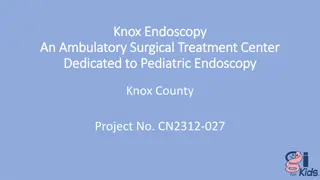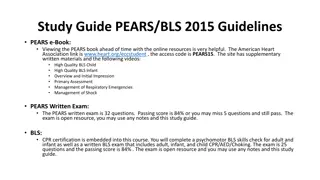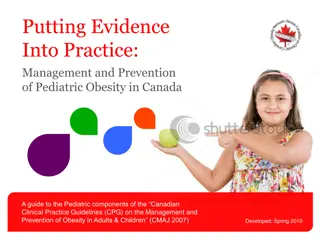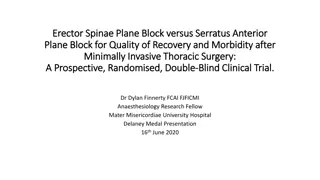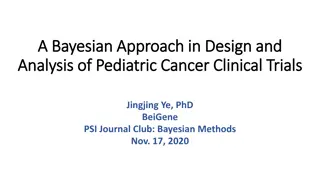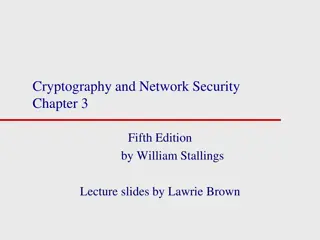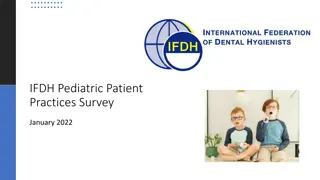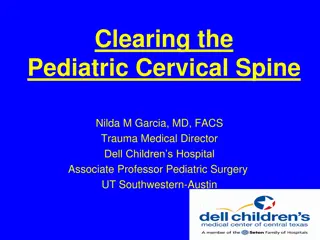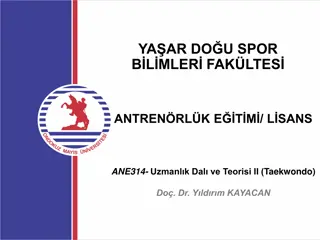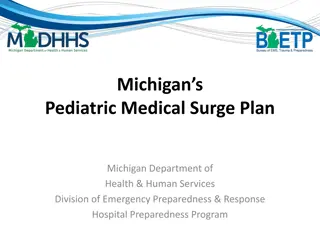Case Study: A New Kid on the Block - Pediatric Presentation
An 11-year-old girl presented with a four-month history of fever, three months of generalized weakness and body ache, and a recent weight loss. Physical examination revealed pallor, edema, generalized tenderness, lymphadenopathy, and telangiectatic rash. Vitals showed elevated respiratory and heart rates, low blood pressure, and fever. Systemic examination indicated liver and splenic enlargement. Differential diagnoses include malignancies, infective etiologies, and connective tissue disorders. Blood investigations showed anemia, leukocytosis, and thrombocytopenia. Further investigations are pending.
Download Presentation

Please find below an Image/Link to download the presentation.
The content on the website is provided AS IS for your information and personal use only. It may not be sold, licensed, or shared on other websites without obtaining consent from the author.If you encounter any issues during the download, it is possible that the publisher has removed the file from their server.
You are allowed to download the files provided on this website for personal or commercial use, subject to the condition that they are used lawfully. All files are the property of their respective owners.
The content on the website is provided AS IS for your information and personal use only. It may not be sold, licensed, or shared on other websites without obtaining consent from the author.
E N D
Presentation Transcript
A NEW KID ON THE BLOCK BY SOUMYADIP PARIA 1STYEAR PGT DEPARTMENT OF PAEDIATRICS, CNMCH
11 year old girl presented with complaints of. a. fever for 4 months b. generalised weakness & bodyache for 3 months c. loss of 5kg weight in 3 months past history - nothing significant - no drug history - no h/o contact with tuberculosis
GENERAL SURVEY GENERAL SURVEY Head Head- -to to- -toe examination toe examination alert pallor ++ edema + generalized tenderness ( including BONY tenderness) lymphadenopathy-cervical & inguinal B/L inflammed ankle joints telengectic rash over digit palm & sole NO cyanosis clubbing icterus Axillary lymphadenopathy rash oral ulcer erythematous conjunctiva
GENERAL GENERAL SURVEY Vitals Vitals SURVEY Resp rate 32 per minute Heart rate 122 per minute BP 98/58 mmhg ( target BP 101/61) Temp 101*F Spo2 99% in Room air
SYSTEMIC EXAMINATION SYSTEMIC EXAMINATION GI examination Liver: 4cm palpable below RCM,Liver span : 12cm , consistency: firm splenomegaly 3.5cm from 10th costal cartilage Respiratory examination B/L VBS , no crepts or wheeze CVS examination Apex beat at normal position, S1, S2 muffled , no murmur
The possibilities !!! The possibilities !!! Malignancies Infective etiologies Connective tissue disorders
INVESTIGATIONS: BLOOD INVESTIGATIONS: BLOOD COMPLETE BLOOD COUNT Hb 8.1 gm/dl WBC 7800/cu.mm( 75% neutrphil, 20% lymhocyte) Platelets 2.7 lakh/cu.mm PBS: Hypochromic, anisocytosis,no abnormal lymhocyte was noted ESR 56 CRP LFT,RFT: WNL Urine RE, ME: WNL ANA panel, Rheumatoid factor(RF): sent,awaited Urine C&S :sent,awaited Blood culture : sent,awaited
INVESTIGATIONS:IMAGING INVESTIGATIONS:IMAGING X-ray & USG of B/L ankle joint :NAD USG WHOLE ABDOMEN & CHEST hepatomegaly( heterogenous echotexture) splenomegaly minimal left sided pleural effusion ascitis minimal percardial effusion ECHOCARDIOGRAPHY: Minimal pericardial effusion, EF 65%
INVESTIGATIONS: others INVESTIGATIONS: others CBNAAT for sputum & gastric lavage TST with 2 TU of PPD DCT - sent
COURSE IN HOSPITAL : DAY 2 TREATMENT started with EMPIRICAL ANTIBIOTICS:Inj.Ceftriaxone) and other SUPPORTIVE MANAGEMENT(Anti-pyretics,IVF etc) COURSE IN HOSPITAL: DAY 7 Blood c/s : pseudomonas spp. Sensitive to piperacillin-tazobactum Urine CS :sterile Sensitive IV antibiotics started
COURSE IN HOSPITAL : DAY 10 Dramatic improvement !!! her general well being improved generalised tenderness vanished complete remission of fever PROVISIONAL DIAGNOSIS: SEPSIS or underneath laid a box of pandora . we had more to explore
COURSE IN HOSPITAL : DAY 20 DETERIORATION AGAIN!!!!! general well being diminished generalised tenderness returned back We reviewed her history .. CBNAAT report :negative TST did not showed any induration
while checking her previous prescriptions from outside (which we should have done earlier) we found that she received a short course of steroid a month ago!!!! was it leukemia?? was the pbs picture normal due to steroid??? we had lots of unanswered questions . Blood for LDH & Uric acid NEXT SET OF INVESTIGATIONS: Bone marrow aspiration
LDH: 888 U/L Uric acid : 5.6mg/dl Was the LDH value indicating towards malignancy?? we had to wait for the BMA report
Bone marrow aspiration revealed Bone marrow aspiration revealed .. .. Myeloid hyperplasia(8:1) 7% blast cell infective?/ inflammatory?etiology ..no definitive conclusion was drawn in view of receiving steroid
We were stuck in the middle.. a repeat CBC revealed . Hb 6.4gm/dl WBC 3300/cu.mm ( neutrophil 43%, lymphocyte 51%) platelet: adequate on smear Bicytopenia was evident Perioral peeling reappeared
SUMMARISING SUMMARISING Fever Weight loss Bicytopenia Generalised tenderness Pericardial effusion & pleural effusion (Serositis) Hepatomegaly Was a connective tissue disorder in vogue??? ANA panel & rhematoid factor report came
ANA panel ANA 3+ SSA native ++ RO52 recombinant ++ Anti Nucleosome Ab + C3 , C4 lower than normal dsDNA negative RHEUMATOID FACTOR CAME NEGATIVE a case of SLE ???
Further management Further management Rheumatologist s opinion was sought was started on HYDROXOCHLOROQUIINE(100mg) TAB BD A repeat ANA panel was sent
PROVISIONAL DIAGNOSIS : SYSTEMIC LUPUS ERYTHOMATOSUS ANTI dsDNA NEGATIVE AND Anti-Nucleosome (nuc) antibody POSITIVE.
A NEW ERA ??? A NEW ERA ??? ANTI NUCLEOSOME ANTIBODY is positive in anti ds DNA negative patients ANTI NCS antibody more sensitive than anti ds DNA as marker of disease activity 1.Pradhan VD, Patwardhan MM, Ghosh K. Anti-nucleosome antibodies as a disease marker in systemic lupus erythematosus and its correlation with disease activity and other autoantibodies. Indian J Dermatol Venereol Leprol. 2010 Mar-Apr;76(2):145-9. doi: 10.4103/0378-6323.60558. PMID: 20228543. 2. Mayada Ali Abdalla, Shereen Ali Elmofty, Ahmed Amin Elmaghraby, Rania Hassan Khalifa, Volume 40, Issue 1,2018,Pages 29-33,ISSN 1110-1164,https://doi.org/10.1016/j.ejr.2017.05.004 3. J. A. Simo n, J. Cabiedes, E. Ortiz, J. Alcocer-Varela, J. Sa nchez-Guerrero, Anti-nucleosome antibodies in patients with systemic lupus erythematosus of recent onset. Potential utility as a diagnostic tool and disease activity marker, Rheumatology, Volume 43, Issue 2, February 2004, Pages 220 224, https://doi.org/10.1093/rheumatology/keh024.
Something more Something more Is Pseudomonas most common in SLE infections??? 1.IDCases. 2014; 1(4): 70 71.Published online 2014 Sep 16. doi: 10.1016/j.idcr.2014.09.001PMCID: PMC4735035PMID: 26839777Veenu Gill,a, Jatinbhai Patel,b,1 Sanjana Koshy,c,2 and Tessa Gomezb,3 2. Hayashi, Yoshio & Fukutomi, Takeshi & Ohmatsu, Hanako. (2019). Cellulitis with Pseudomonas putida bacteremia in a patient with systemic lupus erythematosus: A case report. The Journal of Dermatology. 47. 10.1111/1346-8138.15131.
Take home message Take home message SAY TO STEROID BEFORE CONFIRMING DIAGNOSIS
Take home message Take home message Anti nucleosome antibody -??? A NEW TOOL IN DIAGNOSTIC CRITERIA OF SLE Gram negative bacteriological coverage including pseudomonas - NEEDED






